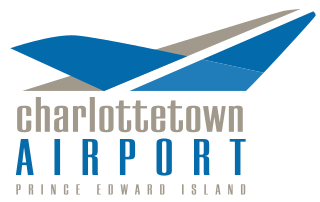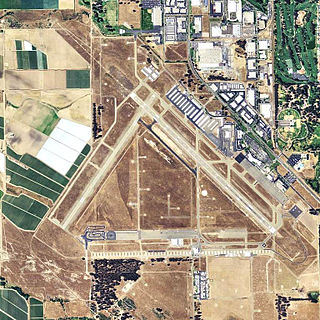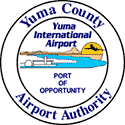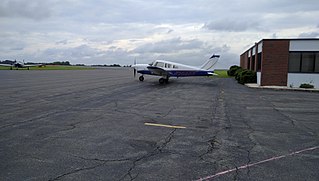Related Research Articles

Phoenix Sky Harbor International Airport is a civil-military public airport 3 miles east of downtown Phoenix, in Maricopa County, Arizona, United States. It is Arizona's largest and busiest airport, and among the largest commercial airports in the United States; in 2021, PHX was the 8th-busiest airport in the United States and 11th-busiest in the world. The airport serves as a hub for American Airlines and a base for Southwest Airlines. In 2021, Southwest carried nearly 35% of all PHX passengers, making it the airport's largest carrier and surpassing American for the first time in years.

Western Airlines was a major airline based in California, operating in the western United States including Alaska and Hawaii, and western Canada, as well as to New York City, Boston, Washington, D.C., and Miami and to Mexico, London and Nassau. Western had hubs at Los Angeles International Airport, Salt Lake City International Airport, and the former Stapleton International Airport in Denver. Before it merged with Delta Air Lines in 1987 it was headquartered at Los Angeles International Airport (LAX). Throughout the company's history, their slogan was "Western Airlines...The Only Way to Fly!"

Louis Armstrong New Orleans International Airport is an international airport under Class B airspace in Kenner, Jefferson Parish, Louisiana, United States. It is owned by the city of New Orleans and is 11 miles (18 km) west of downtown New Orleans. A small portion of Runway 11/29 is in unincorporated St. Charles Parish. Armstrong International is the primary commercial airport for the New Orleans metropolitan area and southeast Louisiana.
El Paso International Airport is four miles (6 km) northeast of downtown El Paso, in El Paso County, Texas, United States. It is the largest civil airport in West Texas. It handled 3,516,911 passengers in 2019.

Charlottetown Airport is located 3 nautical miles north of Charlottetown, Prince Edward Island, Canada. The airport is currently run by the Charlottetown Airport Authority, is owned by Transport Canada and forms part of the National Airports System.

Palm Springs International Airport, formerly Palm Springs Municipal Airport, is an airport two miles (3 km) east of downtown Palm Springs, California, United States. The airport covers 940 acres (380 ha) and has two runways. The facility operates year-round, with most flights occurring in the fall, winter, and spring.

Santa Maria Public Airport is three miles (5 km) south of Santa Maria, in northern Santa Barbara County, California, United States.

Roswell Air Center is an airport five miles (8.0 km) south of Roswell, in Chaves County, New Mexico, United States.

Yuma International Airport is a joint use airport with civilian and military flight activity operated in conjunction with the U.S. Marine Corps via the Marine Corps Air Station Yuma. The airfield is located 3.5 miles south of the central business district of Yuma, a city in Yuma County, Arizona, United States and 150 miles east of San Diego International Airport. It is mostly used for military aviation, but is also served by one commercial airline and one aeromedical Medevac company as well as being used for general aviation activities.

Grand Canyon National Park Airport is a state-owned public-use airport located in Tusayan, CDP in unincorporated Coconino County, Arizona, United States. It is near Grand Canyon National Park, 7 miles from the South Rim of the Grand Canyon. The airport is primarily used for scenic tours and charter flights.

Brownsville/South Padre Island International Airport is 5 miles east of downtown Brownsville, Cameron County, Texas.

Smith Reynolds Airport is a public airport 3 miles (5 km) northeast of Winston-Salem in Forsyth County, North Carolina. The airport has two runways, and is used for general aviation and flight training as there is now no scheduled passenger airline. It is home to the Winston-Salem air show, usually held in September, which draws about 20,000 spectators.

Pinal Airpark, also known as Pinal County Airpark, is a non-towered, county-owned, public-use airport located 8 miles northwest of the central business district of Marana, in Pinal County, Arizona, United States. Silverbell Army Heliport is co-located with Pinal Airpark. The heliport is a private-use military facility operated by the Arizona Army National Guard.

Isabella Greenway was an American politician who was the first congresswoman in Arizona history, and as the founder of the Arizona Inn of Tucson. During her life she was also noted as a one-time owner and operator of Los Angeles-based Gilpin Airlines, a speaker at the 1932 Democratic National Convention, and a bridesmaid at the wedding of Eleanor and Franklin D. Roosevelt.

Cheddi Jagan International Airport, formerly Timehri International Airport, is the primary airport of Guyana. The airport is located on the right bank of the Demerara River in the city of Timehri, 41 kilometres (25 mi) south of Guyana's capital, Georgetown. It is the larger of the two international airports serving Georgetown with the other airport being the Eugene F. Correira International Airport.

William John "Jack" Frye was an aviation pioneer in the airline industry. Frye founded Standard Air Lines which eventually took him into a merger with Trans World Airlines (TWA) where he became president. Frye is credited for turning TWA into a world-class airline during his tenure as president from 1934 to 1947.

Bonanza Air Lines was an airline in the Western United States from 1945 until it merged with two other local service airlines to form Air West in 1968. Its headquarters was initially Las Vegas, Nevada, and moved to Phoenix, Arizona in 1966.

Maddux Air Lines was an airline based in Southern California that operated Ford Tri-motors in California, Arizona, and Mexico in the late 1920s.

Shellharbour Airport, formerly Illawarra Regional Airport, also referred as Albion Park Aerodrome or Wollongong Airport, is an airport located in Albion Park Rail, Shellharbour City, New South Wales, Australia. The Historical Aircraft Restoration Society (HARS) is located at the airport. The airline Link Airways offers daily services from the airport to Melbourne–Essendon and Brisbane.

Wake Island Airfield is a military air base located on Wake Island, which is known for the Battle of Wake Island during World War II. It is owned by the U.S. Air Force and operated by the 611th Air Support Group. The airfield primarily serves military flight activity within the Wake Island region; however, military presence is minimal at the current time. The runway can be used for emergency landings by commercial jetliners flying transpacific routes and has been used in the past by airlines operating jet, turboprop and prop aircraft on scheduled flights.
References
The papers of Gilpin Air Lines are preserved in great detail in the Greenway Collection and the Walter Douglas, Jr. Collection of the Arizona Historical Society, Tucson. Memorabilia can be found on the Davis-Monthan historical website (below). The AAHS article chronicles Pickwick and the Bach Air Yacht. The airline is described in the book Enfant Terrible, (below).